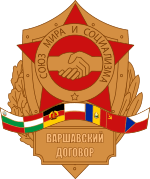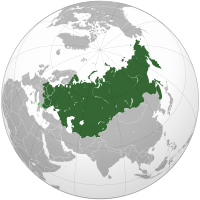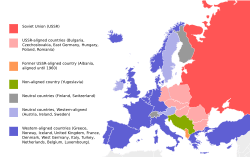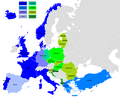Warsaw Pact facts for kids
 |
|

The WTO in 1990
|
|
| Abbreviation | WTO, WAPA, DDSV |
|---|---|
| Motto | Union of peace and socialism |
| Founded | 14 May 1955 |
| Founded at | Warsaw, Poland |
| Dissolved | 1 July 1991 |
| Type | Military alliance |
| Headquarters | Moscow, Soviet Union |
|
Membership
|
|
|
Supreme Commander
|
|
|
Chief of Combined Staff
|
|
| Affiliations | Council for Mutual Economic Assistance |
- Distinguish from the Warsaw Convention, which is an agreement about financial liability in air travel, and the Treaty of Warsaw (1970) between West Germany and the People's Republic of Poland.
The Warsaw Pact, officially the Treaty of Friendship, Cooperation and Mutual Assistance, was an organization of Central and Eastern European Communist states. The states were all allies and would fight together if one of them was attacked. While in theory all the countries in the organisation were equals, the smaller countries were controlled by the Soviet Union.
It was established in 1955 in Warsaw, Poland in response to West Germany joining the North Atlantic Treaty Organization(NATO). The treaty was signed in Warsaw, on 14 May 1955 and official copies were made in the languages of Russian, Polish, Czech and German. The Pact lasted until the end of the Cold War when some members quit in 1991, following the collapse of the Eastern bloc and political changes in the Soviet Union.
Members
- Soviet Union (main contributor)
- East Germany
- Czechoslovakia
- Bulgaria
- Hungary
- Poland
- Romania
- Albania (withdrew its support in 1962 over ideological differences, formally left in 1968)
All the Communist states of Central and Eastern Europe signed except Yugoslavia.
Notes
Images for kids
-
The Presidential Palace in Warsaw, Poland, where the Warsaw Pact was established and signed on 14 May 1955
-
Meeting of the seven representatives of the Warsaw Pact countries in East Berlin in May 1987. From left to right: Gustáv Husák, Todor Zhivkov, Erich Honecker, Mikhail Gorbachev, Nicolae Ceaușescu, Wojciech Jaruzelski, and János Kádár
-
Soviet tanks, marked with white crosses to distinguish them from Czechoslovak tanks, on the streets of Prague during the Warsaw Pact invasion of Czechoslovakia, 1968
-
The Pan-European Picnic took place on the Hungarian-Austrian border.
-
Expansion of NATO before and after the collapse of communism throughout Central and Eastern Europe
See also
 In Spanish: Pacto de Varsovia para niños
In Spanish: Pacto de Varsovia para niños









